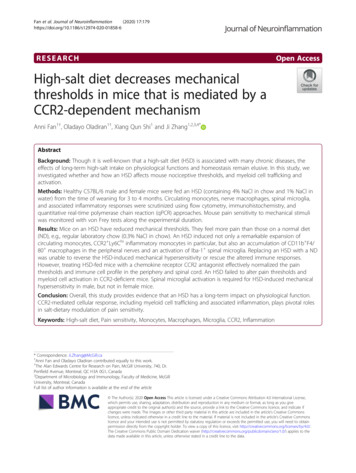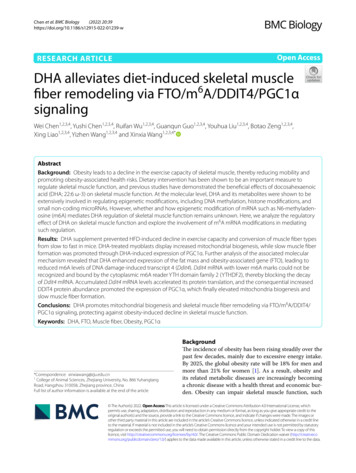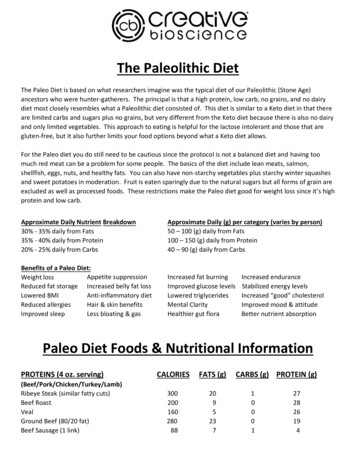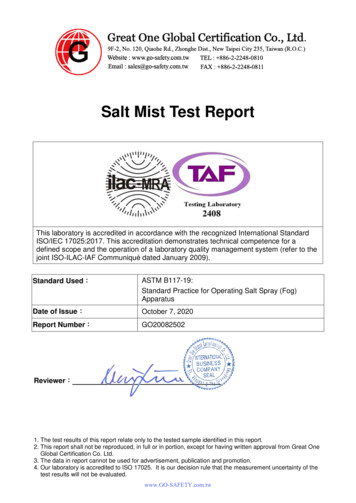
Transcription
Fan et al. Journal of Neuroinflammation(2020) SEARCHOpen AccessHigh-salt diet decreases mechanicalthresholds in mice that is mediated by aCCR2-dependent mechanismAnni Fan1†, Oladayo Oladiran1†, Xiang Qun Shi1 and Ji Zhang1,2,3,4*AbstractBackground: Though it is well-known that a high-salt diet (HSD) is associated with many chronic diseases, theeffects of long-term high-salt intake on physiological functions and homeostasis remain elusive. In this study, weinvestigated whether and how an HSD affects mouse nociceptive thresholds, and myeloid cell trafficking andactivation.Methods: Healthy C57BL/6 male and female mice were fed an HSD (containing 4% NaCl in chow and 1% NaCl inwater) from the time of weaning for 3 to 4 months. Circulating monocytes, nerve macrophages, spinal microglia,and associated inflammatory responses were scrutinized using flow cytometry, immunohistochemistry, andquantitative real-time polymerase chain reaction (qPCR) approaches. Mouse pain sensitivity to mechanical stimuliwas monitored with von Frey tests along the experimental duration.Results: Mice on an HSD have reduced mechanical thresholds. They feel more pain than those on a normal diet(ND), e.g., regular laboratory chow (0.3% NaCl in chow). An HSD induced not only a remarkable expansion ofcirculating monocytes, CCR2 Ly6Chi inflammatory monocytes in particular, but also an accumulation of CD11b F4/80 macrophages in the peripheral nerves and an activation of Iba-1 spinal microglia. Replacing an HSD with a NDwas unable to reverse the HSD-induced mechanical hypersensitivity or rescue the altered immune responses.However, treating HSD-fed mice with a chemokine receptor CCR2 antagonist effectively normalized the painthresholds and immune cell profile in the periphery and spinal cord. An HSD failed to alter pain thresholds andmyeloid cell activation in CCR2-deficient mice. Spinal microglial activation is required for HSD-induced mechanicalhypersensitivity in male, but not in female mice.Conclusion: Overall, this study provides evidence that an HSD has a long-term impact on physiological function.CCR2-mediated cellular response, including myeloid cell trafficking and associated inflammation, plays pivotal rolesin salt-dietary modulation of pain sensitivity.Keywords: High-salt diet, Pain sensitivity, Monocytes, Macrophages, Microglia, CCR2, Inflammation* Correspondence: Ji.Zhang@McGill.ca†Anni Fan and Oladayo Oladiran contributed equally to this work.1The Alan Edwards Centre for Research on Pain, McGill University, 740, Dr.Penfield Avenue, Montreal, QC H3A 0G1, Canada2Department of Microbiology and Immunology, Faculty of Medicine, McGillUniversity, Montreal, CanadaFull list of author information is available at the end of the article The Author(s). 2020 Open Access This article is licensed under a Creative Commons Attribution 4.0 International License,which permits use, sharing, adaptation, distribution and reproduction in any medium or format, as long as you giveappropriate credit to the original author(s) and the source, provide a link to the Creative Commons licence, and indicate ifchanges were made. The images or other third party material in this article are included in the article's Creative Commonslicence, unless indicated otherwise in a credit line to the material. If material is not included in the article's Creative Commonslicence and your intended use is not permitted by statutory regulation or exceeds the permitted use, you will need to obtainpermission directly from the copyright holder. To view a copy of this licence, visit http://creativecommons.org/licenses/by/4.0/.The Creative Commons Public Domain Dedication waiver ) applies to thedata made available in this article, unless otherwise stated in a credit line to the data.
Fan et al. Journal of Neuroinflammation(2020) 17:179BackgroundA healthy diet provides human bodies with essential nutrients and certain “signals” needed to maintain wellness.Sodium plays a vital role in the regulation of manyphysiological functions, including blood volume maintenance, water balance, cell membrane potential, acidbase balance, and nerve conduction. While the minimum physiological requirement for sodium is 500 mgper day and the dietary guidelines for Americans [1] suggests less than 2300 mg of daily sodium intake, adultmen in the USA consume on average 4240 mg per daywhile women consume 2980 mg, primarily from processed food.Excess salt intake has been linked to many chronic diseases, including hypertension, cardiovascular disease,kidney dysfunction, and osteoporosis [2–5]. While an increase in salt-enriched “fast food” consumption has beenconsidered a putative factor for many pathological conditions, there is no (animal or human) data available todelineate whether a long-term high-salt diet (HSD) maydisturb pain sensitivity. The ability to sense pain is oneof the prerequisites for survival. By detecting harmfulstimuli and responding quickly, people can protectthemselves from damage. Thresholds to painful stimulimay vary among individuals, often attributed to geneticvariances, but it is interesting to examine whether a subject’s environment, lifestyle, or diet impacts their abilityto sense pain.While noxious signals are detected, transmitted, andperceived within the sensory nervous system, from theperiphery to the central, recent evidence strongly suggests that the immune system, once activated, may beinvolved in modulating neuronal function, which mayresult in altered pain behavior [6, 7]. Several studies haverevealed that an HSD affects the immune system, including both innate and adaptive immunity. High salt levelsincrease the expression of proinflammatory moleculeswhile decreasing the anti-inflammatory ones in both human and mouse macrophages. This leads to a saltspecific macrophage activation [8]. High salt levels alsoalter the phenotypes of T cells by inducing pathogenicTh17 development [9] and inhibiting the suppressivefunction of FoxP3 T regulatory (Tregs) [10, 11]. Experimental autoimmune encephalomyelitis (EAE) was exacerbated in mice on an HSD [12]. In addition, excess saltaggravated cerebral blood-brain barrier disruption inmouse models of cerebral ischemia, which facilitatedleukocyte trafficking [13]. Excessive levels of salt likelyhave pro-inflammatory properties. Nevertheless, whetherand how HSD-associated inflammation affects pain sensitivity remains to be determined.In this study, we aim to 1) determine whether dietaryhabits can impact an individual’s pain threshold byassessing the ability of mice on a long-term HSD toPage 2 of 16sense pain and 2) investigate how an HSD disturbs thehomeostasis of the immune and nervous systems, leading to altered pain sensitivity. We observed that mice ona long-term HSD felt more pain. The HSDs triggeredmyeloid cell activation, including an expansion of circulating monocytes, an increased recruitment of nervemacrophages, and spinal microglia. Innate immune cellswere polarized toward proinflammatory status by continued high-salt feeding. Once established, an HSDinduced altered immune function and mechanical hypersensitivity were irreversible even if the subject returnedto a normal diet (ND). Chemokine receptor CCR2mediated myeloid cell trafficking/activation played a crucial role in this cascade. Spinal microglia activation is required for HSD-induced hypersensitivity in male but notin female mice.Materials and methodsAnimalsC57BL/6 and CCR2 knock out (CCR2KO) male and female mice were bred in house. There were three to fivemice per cage in a temperature and humidity-controlledroom that maintained a 12/12-h light/dark cycle. Micehad free access to water and food ad libitum. Animalbody weight was monitored weekly during dietary intervention. Behavioral experiments were conducted between 9:00 AM and 3:00 PM. All experiments wereapproved by the Institutional Animal Care and UseCommittee of McGill University (Permit # 5775) andconformed to the ethical guidelines of the InternationalAssociation of the Study of Pain.Animal feeding paradigmThe HSDs were initiated during the weaning period (3weeks old). The HSD regimen consisted of 4% NaCl inchow and 1% NaCl in water [12, 14]. Mice on a normaldiet (ND) received regular laboratory chow [0.3% NaClin the pelleted food from the Teklad irradiated laboratory animal diet (Envigo)] and distilled water. Accordingto the experimental design, the HSD was maintained fora duration of 1.5 to 4 months. C57BL6 mice were resistant to HSD-induced hypertension [15] and their sodiumplasma concentration was not affected following 3months HSD feeding (data not shown). In most measurements, we did not observe significant differences between HSD-fed male and female mice. Therefore, unlessotherwise specified, results represent the combined datacollected from both male and female mice.Pain behavioral testsPain behavioral monitoring began after 3 weeks of HSD/ND feeding. Mice were habituated to the testing environment for at least 2 days before testing. The investigator responsible for the behavioral test was blinded to the
Fan et al. Journal of Neuroinflammation(2020) 17:179Page 3 of 16treatment conditions. The von Frey Test was used to assess paw sensitivity to mechanical stimuli. Mice wereplaced in a plastic cage with a wire mesh floor thatallowed access to the paws. Calibrated monofilaments(Stoelting) were applied perpendicular to the plantarsurface of the hind paw using the up-down method. Thepaw was touched using a set of eight calibrated von Freyhairs with ranging intensity (from 0.008 to 1.40 g offorce). A sharp withdrawing of the paw and immediateflinching upon the removal of the monofilaments wereconsidered a positive response. Two consecutive tests,separated by at least 1 h, were performed, and the average result of the two tests was recorded as the 50% pawwithdrawal thresholds.Flow cytometrySingle cell suspension from blood, sciatic nerve, andspinal cord was prepared as previously described [16]. Inshort, whole blood was collected from the submandibular vein plexus of mice and kept in in Alsever’ssolution (Gibco) to prevent coagulation. After a briefspin down and the removal of the supernatant, sampleswere incubated in ACK lysing buffer (Thermo FisherScientific) at room temperature for 5 min to depleteerythrocytes. Sciatic nerves (bilateral, 2.2 cm each) andlumbar spinal cord (1 cm) were obtained after being perfused transcardially with 0.9% saline. Tissue sampleswere diced into small pieces (approximately 1 mm3) andincubated in RPMI-1640 medium containing collagenase(1.6 mg/ml, Sigma-Aldrich) and DNAase (250 units/ml,Sigma-Aldrich) for digestion at 37 C for 30 min. Thedigested samples were filtered through a 70-μm cellstrainer to remove debris. After filtration and washing,single cells were incubated with a 2.4G2 blocking bufferfor 30 min at 4 C and then stained with specificfluorochrome-conjugated Abs for 30 min at 4 C. Viability dye (Fixable Viability dye eFluor780, 1:50,eBioscience) was included in the staining. Countingbeads (eBioscience) were also added to each sample toquantify the number of cells per microliter of blood, perTable 1 List of antibodies used for cytoflowmetry analysisnerve, and per 1 cm spinal cord. For intracellular staining, samples were blocked and labeled first with Abs forsurface markers, and then fixed and permeabilized usingBD cytofix/cytoperm TM plus kit. This was followed byincubation with Abs against intracellular proteins(CD206, Ki67). Data was acquired with FACS Canto II(BD) and analyzed with Flowjo software. Detailed information regarding the Abs used here is listed in Table 1.ImmunohistochemistryMice were transcardially perfused with 0.9% NaCl, whichwas then followed by 4% paraformaldehyde (PFA) (in 0.1M sodium phosphate buffer with 7.4 pH) perfusion.Spinal cords and sciatic nerves were harvested for immunohistochemistry staining. Tissues were post-fixedovernight in 4% PFA at 4 C and then transferred to a30% sucrose in phosphate buffer until cryostat/microtome sectioning. Sciatic nerves (14 μm) and lumbarspinal cord sections (25 μm, free-floating) were first incubated in a blocking buffer (3% normal rabbit serum,1% bovine serum albumin, and 0.25% Triton X-100 in1X Tris-buffered saline) for 1 h at room temperaturethen incubated with the respective antibodies (Table 2)overnight at 4 C. This was followed by a 1-h incubationwith fluorochrome-conjugated secondary antibodies andDAPI for nuclear staining. After staining, Vectashieldmounting medium (Vector Laboratories) was applied forfluorescent microscopic examination.Image analysis and quantificationSciatic nerve and lumbar spinal cord sections were examined under the fluorescent Olympus BX51 microscope bearing a color digital camera (Olympus DP71).Images were acquired under the same set of parameters(image processing, picture size, and orientation) and atthe optimal intensity to avoid an over-saturation of signals. Ionized calcium binding adaptor molecule 1 (Iba-1)and CD16-32 stained cells were quantified using thesame area of interest (AOI) on the superficial layers ofthe spinal dorsal horns for all samples. Eight to ten sections per animal and three to four animals per groupwere included for quantification using ImagePro software. The investigator was blinded to the g numberCloneCD451:50BD pharmingen56050130-F11CD11b1:50BD D SerotecMCA2235A6477MR503Table 2 List of antibodies used for cytoflowmetry ilutionSourceCatalog 82SOIA15C16/CD321:200R&DAF1460
Fan et al. Journal of Neuroinflammation(2020) 17:179Page 4 of 16Plasma and urine osmolality measurementStatistical analysisMale and female mice plasma and urine osmolality(mOsm/kg) were measured using the freezing point osmometer. The plasma/urine samples (20 μl) were collected from mice under ND and 1 or 3 months of HSDfeeding. The final values of plasma/urine osmolality werereported as the average of triplicate measurements.All data is presented as mean SEM. GraphPad Prism (v.7.0) was used for statistical analysis. The different statistical analyses used in each experiment are indicated in thefigure legends. In general, an unpaired Student’s t test wasused for single comparisons between groups, and a twoway ANOVA, followed by Bonferroni’s post hoc analysistests, was used for multiple comparisons. For all analyses,statistical significance was assigned at p 0.05.RNA extraction and real-time quantitative PCRWhole blood was collected from the sub-mandibularvein plexus and lyzed by Ack Lysing Buffer. Sciaticnerves were harvested following transcardiac perfusedwith 0.9% NaCl fresh-frozen at 80 C. Tissue sampleswere homogenized in a Precellys 24 tissue homogenizer(Bertin Technologies) using two 20-s pulses at 5600rpm. The total RNA of the blood and sciatic nerves wasextracted using TRIzol Reagent (Ambion Life Technologies, Carlsbad, CA) according to the manufacturer’s instructions. The ratio of absorbance at 260 and 280 nmwas measured by a Nanodrop2000 (Thermo Scientific,Wilmington, DE) to assess purity and the concentrationof RNA. For reverse transcription, 2.5 μg template RNAwas added to SuperScript IV Reverse Transcriptase(Invitrogen). After reverse transcription, quantitativeRT-PCR was run using 2.5 μl cDNA and SYBR greenchemistry (Bio-Rad) following the supplier’s protocoland a cycling program of 2 min at 95 C, followed by 40cycles of 95 C for 3 s and 60 C for 30 s, 15 h at 70 C,and hold at 4 C on the Rotor-Gene Q (QIAGEN).Mouse qPCR primer sequences for cytokines tested arelisted in Table 3. Data was analyzed with the ΔΔCtmethod using GAPDH as a housekeeping gene [17].CCR2 antagonist and minocycline treatmentRS 102895 hydrochloride (Sigma-Aldrich), a chemokinereceptor CCR2 antagonist [18], was given either intraperitoneally (I.P.) or intrathecally (I.T.) to male/femalemice after 3 months of HSD feeding. RS 102895 was administered daily at a dosage of 15 mg/kg of body weight,I.P. or I.T, for two consecutive days before tissue collection. Minocycline was given I.P. to a separate group ofHSD-fed mice, 25 mg/kg, for three consecutive days. Behavioral tests were performed before the injection (asbaseline value) and 24 h after each drug administration.ResultsAn HSD induces long-lasting mechanical hypersensitivityin mice, which is not made reversible by returning to anormal dietTo mimic the circumstances in certain regions of theworld wherein people grow up with a higher-thanaverage salt intake [19], we began feeding mice an HSDdirectly after weaning, at the age of 3 weeks. There wasno difference in the amount of body weight gained between HSD and ND fed mice (Fig. 1a). Mice in bothgroups experienced a rapid increase in body weight inthe first month and afterwards gained weight at a steadyrate (Fig. 1a). In addition, mice did not appear to beobsessed with high-salt food because their daily food intake was similar in the HSD and ND groups (Fig. 1b).However, mice on an HSD had a significant increase inwater consumption (Fig. 1c). We also measured plasmaand urine osmolality to understand the impact of longterm HSD on osmoregulation. Three months of high-saltfeeding increased plasma osmolality in both male and female mice, while 1 month of an HSD only elevated plasmaosmolality in male mice but not female mice. This indicates that male mice have a quicker response to excessivesalt than females (Fig. 1d). Interestingly, for both male andfemale mice, 1 month of excessive salt intake initially induced an increase in urine osmolality, which was normalized after 3 months of an HSD (Fig. 1e).To investigate the effect of an HSD on nociceptivepain behavior, we performed weekly von Frey tests onmouse hind paws to measure their sensitivity to mechanical stimuli. A decrease in the mechanical withdrawalthresholds of HSD-fed mice reached significance onweek 6 and maintained this significance until the end ofthe experimental period (Fig. 2a). These results revealedthat a long-term HSD could change individual’s painTable 3 Primer sequences used for real-time quantitative PCR experimentsForwardReverse5′ AAT GCA TCC TGC ACC ACC AAC T-3′5′ AGT GAT GGC ATG GAC TGT CGT CAT-3′IL-1β5′ CTA TAC CTG TCC TGT GTA-3′5′ GCT CTT GAC TTC TAT CTT GTT G-3′ΙL-65′ CTG AA CTT CCA GAG ATA C-3′5′ TTC ATG TAC TCC AGG TAG-3′CCL25′ CTA CTC ATT CAC CAG CAA GA-3′5′ TCA GCA CAG ACC TCT CTC-3′CCR25′ AGA AGA GG CAT TGG ATT-3′5′ CGT GGA TGA ACT GAG GTA-3′GAPDH
Fan et al. Journal of Neuroinflammation(2020) 17:179Page 5 of 16Fig. 1 An HSD has no effect on body weight and food intake but does increase water consumption, which affects mouse plasma and urineosmolality. a The bodyweights (g) of male/female mice on HSD and ND were recorded for 3 months, n 10–14/group. No significant differencewas observed between HSD and ND fed mice. b High-salt and regular laboratory chow intake (g) was measured, n 10–12/group. No significantdifference was observed between HSD and ND fed mice. c Average distilled water and 1% NaCl water (g) consumption were recorded on aweekly basis, n 10–12/group. Mice on an HSD drunk significantly more water than mice on a ND. Male and female mice plasma (d) and urine(e) osmolality (mOsm/kg) was monitored at 1 month and 3 months during special diet feeding, n 3–4/group. All data were presented as mean SEM, and data was analyzed with unpaired t test, *p 0.05, **p 0.01, ***p 0.001, ****p 0.0001sensitivity. We further observed that HSD-induced mechanical hypersensitivity is non-reversible, even when an HSDis shifted back to a ND. Mice who underwent 3 months ofan HSD were put on a ND for an additional 2 months. Surprisingly, a ND was not able to restore the decreased pawwithdrawal thresholds to normal levels (Fig. 2b). This wasthe case even with a 1.5-month HSD paradigm, wherein aND was instituted immediately after the onset of mechanical hypersensitivity (Fig. 2c). This suggests that, once established, the mechanical allodynia triggered by HSD is longlasting and cannot be reversed by a ND alone.An HSD triggers monocyte expansion and systemicinflammationIt has been well-established that activated nerve macrophages and spinal microglia [20–22] contribute tochronic pain. In addition, high levels of salt can induce aspecific activation of macrophages [8]. Therefore, wedecided to scrutinize functional changes of myeloid cellsunder a long-term HSD to elucidate the underlying cellular mechanism of HSD-induced hypersensitivity. Indeed, an HSD induced a remarkable expansion ofmonocytes (monocytosis) in the blood. The absolutenumber of CD11b CD115 monocytes significantly increased in HSD mice (Fig. 3a) and there was an enhanced polarization toward CCR2 Ly6Chi inflammatorymonocytes (Fig. 3b) wherein the absolute number increased (Fig. 3a, b). Monocyte expansion was observedat 1 month of HSD feeding (Fig. 3a, b), which was beforethe onset of mechanical hypersensitivity. The number ofcirculating monocytes and pro-inflammatory subsetsremained elevated over the course of HSD feeding (Fig. 3a,b). In addition, mice in the HSD group showed an elevatedmRNA expression of pro-inflammatory cytokines interleukin I-β (IL-1β), interleukin-6 (IL-6), and the chemokine receptor CCR2 in the blood, which were more pronounced at
Fan et al. Journal of Neuroinflammation(2020) 17:179Page 6 of 16Fig. 2 An HSD induces long-lasting hypersensitivity in mice, which is not reversible by returning to a ND. a Paw withdrawal thresholds wereassessed using the von Frey test. Mechanical hypersensitivity was established on week 6 of HSD feeding and maintained until at least 3 months.n 20–22/group. b After 3 months of HSD feeding, the diet regime was replaced by a ND for an additional 2 months, but their HSD-induceddecreased mechanical thresholds remained low, n 16–18/group. c Mechanical hypersensitivity was not reversible even as their diet regime wasshifted back to ND after 1.5 months of HSD feeding, n 14–18/group. Data were combined from male and female mice. All data were presentedas mean SEM. Data were analyzed by two-way ANOVA followed by Bonferroni post-tests, *p 0.05, **p 0.01, ***p 0.001, ****p 0.00011-month of HSD feeding (Fig. 3c). To decipher the originof the monocyte expansion, we assessed the number of proliferating monocytes in ND and HSD mice. Interestingly,the absolute number of Ki67 CD11b CD115 remainedsimilar in both ND and HSD groups, in male and femalemice. The percentage of proliferating monocytes was evenlower in HSD mice as the total monocyte number increased (Fig. 3d). It is also worth noting that, on a ND, themonocyte proliferation rate in male mice (45.18 4.305%)was higher than that in female mice (29.20 4.133%) (Fig.3d). Altogether, it suggests that the increase of circulatingmonocytes is not the result of cell proliferation; instead, itis mainly derived from enhanced egress from bone marrow.To understand why a ND cannot reverse HSD-inducedhypersensitivity, we analyzed blood samples before andafter such dietary shift. Irrespective of the length of HSDfeeding (1.5 months or 3 months), 2 to 2.5 months of a NDwas insufficient to reduce the number of circulating monocytes or normalize the inflammatory subset (Fig. 3a, b).An HSD activates peripheral nerve macrophages andspinal microgliaTo uncover the missing linkage among HSD-inducedmonocyte expansion, systemic inflammation, andmechanical hypersensitivity, we next explored the effect ofan HSD on macrophages in peripheral nerves. Gated onCD45 leukocytes, nerve macrophages were selectedbased on the cell surface markers CD11b and F4/80. Miceon an HSD showed a significant increase in the frequencyand the number of CD11b F4/80 macrophages in the sciatic nerves (Fig. 4a, b). An HSD highly favored the development of CD86 M1-like macrophages than that ofCD206 M2-like macrophages (Fig. 4b, c). A return to aND was unable to bring the number of macrophages tothe normal level; however, there was a trend toward a decrease in the number of CD86 macrophages after thedietary change (Fig. 4b, c). While the total number ofnerve macrophages increased after 1 month and 3 monthsof HSD feeding, the absolute number of Ki67 proliferating macrophages remained similar in the sciatic nerves ofND and HSD mice (Fig. 4d), indicating the increase wasmainly derived from recruitment. As a confirmation of theflow cytometry analysis, we stained the sciatic nerves withF4/80 to label nerve macrophages and CD16/32 (FcγII/IIIreceptor) to highlight their activation status. As depictedin Fig. 4e, the density of F4/80 macrophages in HSD micewas higher than that in ND mice. Most of these macrophages co-expressed CD16/32. These activated pro-
Fan et al. Journal of Neuroinflammation(2020) 17:179Page 7 of 16Fig. 3 An HSD triggers monocyte expansion and systemic inflammation. a Flow cytometry dot plots of the frequency and the quantitativeanalysis of the absolute number showed a significant increase of CD11b CD115 monocytes in the blood of HSD mice. Such increase remainedelevated even after returning to a ND, n 10–14/group. b Flow cytometry dot plots of the frequency and the quantitative analysis of theabsolute number showed a significant increase of CCR2 Ly6Chi inflammatory subset in the blood of HSD mice. Such increase remained elevatedeven after returning to a ND, n 10–14/group. c The mRNA expression of pro-inflammatory molecules, IL-1β, IL-6, and CCR2 at 1 month and 3months of HSD feeding was determined by qPCR, n 6–8/group. d A representative flow cytometry histogram showed the percentage ofKi67 CD11b CD115 monocytes in the blood of HSD/ND-fed mice. A quantitative analysis of absolute cell counts showed that HSD did notinduce significant increases of cell proliferation, while due to the increase of total monocyte number, the percentage of Ki67 monocytes waslower in the HSD group, n 3–4/group. All data was presented as mean SEM, two-way ANOVA followed by the Bonferroni post-tests for a, b,un-paired t test for c, d, *p 0.05, **p 0.01, ***p 0.001, ****p 0.0001inflammatory macrophages may contribute to the elevatedexpression of the pro-inflammatory cytokines IL-1β andIL-6 as seen in the peripheral nerves (Fig. 4f).We further investigated the effects of an HSD onspinal microglia, myeloid cells in the central nervous system. After 2 months of HSD feeding, there was a significant increase in the number of ionized calcium bindingadaptor molecule 1 (Iba1) microglia in the dorsal horn(Fig. 5a), which was maintained for up to 3 months ofHSD feeding. An HSD also induced a significant increase in CD16/32 expression in the spinal cord(Fig. 5b). Similarly, to what has been observed in thecirculating monocytes and nerve macrophages, HSDinduced spinal microglia activation persisted evenafter shifting the diet back to a ND (Fig. 5c). As wasseen in the blood and sciatic nerves, an HSD did notsignificantly induce microglial cell proliferation in thespinal cord (Fig. 5d).
Fan et al. Journal of Neuroinflammation(2020) 17:179Page 8 of 16Fig. 4 An HSD activates peripheral nerve macrophages. a Representative flow cytometry dot plots showed an increase in the frequency ofperipheral nerve macrophages (CD45 CD11b F4/80 ) at 1 and 3 months of HSD feeding. b Histograms depicted the absolute macrophage(CD45 CD11b F4/80 ) number, as well as those that were CD86 macrophages. A quantitative analysis indicated a significant increase at 1 and 3months of HSD feeding, and the number remained elevated after shifting HSD-fed mice to a ND, n 6–9/group. c Histograms depicted theabsolute macrophage (CD45 CD11b F4/80 ) number as well as those that were CD206 macrophages. An HSD favored the differentiation ofCD86 macrophages in the nerve more than those of CD206 macrophages, n 6–9/group. d A representative flow cytometry histogramshowed the percentage of Ki67 macrophages (CD45 CD11b F4/80 ) in the sciatic nerves of HSD and ND fed mice. A quantitative analysisshowed that HSD did not trigger significant macrophage proliferation in nerves, n 6–8/group. e Longitudinal sections of mouse sciatic nerveswere stained with CD16/32 (FcγII/III receptor), F4/80, and DAPI, showing an increased F4/80 macrophage density in HSD nerves primarilycolocalized with CD16/32. f Real-time quantitative PCR showed an elevated expression of IL-1β and IL-6 in the peripheral nerves at three monthsof HSD feeding, n 6–10/group. Data were combined with from male and female mice. All data was presented as mean SEM and analyzedwith an unpaired t test, **p 0.01, ***p 0.001; red and green ## represents statistics for CD86 or CD206 macrophages, respectivelyImpeding CCR2 signaling successfully blocks myeloid celltrafficking and completely reverses HSD-inducedmechanical allodyniaIt is well known that CCR2 signaling is critical for myeloid cell trafficking [23]. The fact that an HSDsignificantly increased the number of CCR2 monocytesin the circulation led us to speculate the importance ofCCR2-mediated monocyte recruitment to the nervoussystem in altering mechanical sensitivity. RS102895, anantagonist of the β-subclass chemokine receptor CCR2
Fan et al. Journal of Neuroinflammation(2020) 17:179Page 9 of 16Fig. 5 An HSD activates spinal microglia. a HSD feeding resulted in a significant increase in the number of Iba-1 microglia in the lumbar spinalcord dorsal horn. b The expression of CD16/32 (FcγII/III receptor), an activation marker, was increased in the lumbar spinal cord of HSD fed mice.c Increased microglia density, as induced by HSD feeding, was maintai
A healthy diet provides human bodies with essential nu- . men in the USA consume on average 4240 mg per day while women consume 2980 mg, primarily from proc-essed food. . fluorochrome-conjuga










